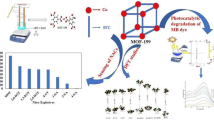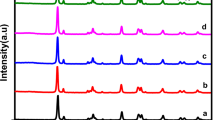Abstract
A low cost imine-decorated linker, 4,4'-(hydrazine-1,2-diylidenedimethylylidene)dibenzoic acid was utilized for the preparation of copper-based metal–organic framework (MOF) denoted as Cu-L via a solvothermal technique. The synthesized MOF material has been fully characterized by different analytical techniques such as Fourier-transform infrared (FT-IR) spectroscopy, powder X-Ray diffraction (PXRD), scanning electron microscopy (SEM), energy dispersive X-Ray spectroscopy (EDX), nitrogen adsorption–desorption isotherm analysis, and thermogravimetric analysis (TGA). It has been found that the coordination of Cu2+ with L considerably reduced the band gap of the L of nearly about 1 eV, which is approximately 26% decline in total. Notably, a narrow band gap of the photocatalyst is an essential requirement for the proficient photodegradation of organic contaminants. An excellent optical properties and narrow band gap of (2.8 eV) of Cu-L ensure their suitability as a photocatalyst for the degradation of methylene blue (MB) dye. In the presence of Cu-L photocatalyst, 84.22% degradation of MB dye was observed after 150 min under sunlight exposure. It is the first time that imine-functionalized MOF was utilized for the degradation of MB dye under sunlight irradiation. For understanding the photodegradation of MB dye by the Cu-L photocatalyst, all the plausible mechanistic studies have been carried out in detail. Both theoretical (with the help of density functional theory (DFT) calculations) as well as experimental studies have been conducted to justify the possible mechanisms for the photodegradation of MB dye by Cu-L. The current work may open a new opportunity to construct a cheap MOF-based photocatalysts for fast degradation of dye contaminants.
Graphical Abstract








Similar content being viewed by others
Availability of Data and Material
Data and material information is provided and will be shared on request.
References
Pozzo RL, Baltanas MA, Cassano AE (1997) Supported titanium oxide as photocatalyst in water decontamination: state of the art. Catal Today 39(3):219–231
Lu M (2013) Photocatalysis and water purification: from fundamentals to recent applications. John Wiley & Sons
Uddin MJ, Ampiaw RE, Lee W (2021) Adsorptive removal of dyes from wastewater using a metal-organic framework: A review. Chemosphere 284:131314
Zango ZU et al (2021) Selective adsorption of dyes and pharmaceuticals from water by UiO metal–organic frameworks: A comprehensive review. Polyhedron 210:115515
Tan KB et al (2015) Adsorption of dyes by nanomaterials: recent developments and adsorption mechanisms. Sep Purif Technol 150:229–242
Brahmi C et al (2021) New hybrid MOF/polymer composites for the photodegradation of organic dyes. Eur Polymer J 154:110560
Wang Y-F et al (2022) Copper-catalyzed asymmetric 1, 6-conjugate addition of in situ generated para-quinone methides with β-ketoesters. Chem Commun 58(46):6653–6656
Yao W et al (2020) Transition-metal-free catalytic hydroboration reduction of amides to amines. Org Chem Front 7(21):3515–3520
Yao W et al (2019) Sodium triethylborohydride-catalyzed controlled reduction of unactivated amides to secondary or tertiary amines. J Org Chem 84(22):14627–14635
Yao W et al (2020) Combined KOH/BEt3 catalyst for selective deaminative hydroboration of aromatic carboxamides for construction of luminophores. Org Lett 22(20):8086–8090
Azar BE et al (2020) Green synthesis and characterization of ZnAl2O4@ ZnO nanocomposite and its environmental applications in rapid dye degradation. Optik 208:164129
Selvaraj V et al (2021) An over review on recently developed techniques, mechanisms and intermediate involved in the advanced azo dye degradation for industrial applications. J Mol Struct 1224:129195
Gupta GK, Mondal MK (2021) Fundamentals and mechanistic pathways of dye degradation using photocatalysts. Photocatalytic degradation of dyes. Elsevier, pp 527–545
Sharma S, Kaur A (2018) Various methods for removal of dyes from industrial effluents-a review. Indian J Sci Technol 11(1)
Bal G, Thakur A (2022) Distinct approaches of removal of dyes from wastewater: A review. Mater Today Proc 50:1575–1579
Yao W et al (2021) Chemoselective hydroborative reduction of nitro motifs using a transition-metal-free catalyst. Org Chem Front 8(16):4554–4559
Pandimurugan R, Thambidurai S (2016) Novel seaweed capped ZnO nanoparticles for effective dye photodegradation and antibacterial activity. Adv Powder Technol 27(4):1062–1072
Ullah R, Dutta J (2008) Photocatalytic degradation of organic dyes with manganese-doped ZnO nanoparticles. J Hazard Mater 156(1–3):194–200
Gautam S et al (2020) Metal oxides and metal organic frameworks for the photocatalytic degradation: A review. J Environ Chem Eng 8(3):103726
Gusain R et al (2019) Adsorptive removal and photocatalytic degradation of organic pollutants using metal oxides and their composites: A comprehensive review. Adv Coll Interface Sci 272:102009
Wang C-C, Wang X, Liu W (2020) The synthesis strategies and photocatalytic performances of TiO2/MOFs composites: a state-of-the-art review. Chem Eng J 391:123601
Mukherjee D, Van der Bruggen B, Mandal B (2022) Advancements in visible light responsive MOF composites for photocatalytic decontamination of textile wastewater: A review. Chemosphere 295:133835
Wu Z et al (2017) Photocatalytic decontamination of wastewater containing organic dyes by metal–organic frameworks and their derivatives. ChemCatChem 9(1):41–64
Liu S-Y et al (2018) One-step rapid synthesis of π-conjugated large oligomers via C-H activation coupling. Org Chem Front 5(4):653–661
Dolgopolova EA et al (2018) Photochemistry and photophysics of MOFs: steps towards MOF-based sensing enhancements. Chem Soc Rev 47(13):4710–4728
Firooz SK, Armstrong DW (2022) Metal-organic frameworks in separations: A review. Anal Chim Acta 340208
Kirchon A et al (2018) From fundamentals to applications: a toolbox for robust and multifunctional MOF materials. Chem Soc Rev 47(23):8611–8638
Kuc A, Enyashin A, Seifert G (2007) Metal− organic frameworks: structural, energetic, electronic, and mechanical properties. J Phys Chem B 111(28):8179–8186
Liu Y et al (2019) Metal or metal-containing nanoparticle@ MOF nanocomposites as a promising type of photocatalyst. Coord Chem Rev 388:63–78
Du J, Yang X, Ge D (2023) Two new 3D supramolecular frameworks as photocatalysts for degradation of methyl blue. J Fluoresc 1:1–9
Farahani YD, Safarifard V (2019) A luminescent metal-organic framework with pre-designed functionalized ligands as an efficient fluorescence sensing for Fe3+ ions. J Solid State Chem 270:428–435
Saravanakkumar D et al (2019) Synthesis and characterization of CuO/ZnO/CNTs thin films on copper substrate and its photocatalytic applications. OpenNano 4:100025
Ghamari Kargar P, Aryanejad S, Bagherzade G (2020) Simple synthesis of the novel Cu-MOF catalysts for the selective alcohol oxidation and the oxidative cross-coupling of amines and alcohols. Appl Organomet Chem 34(12):e5965
Soltani N et al (2012) Visible light-induced degradation of methylene blue in the presence of photocatalytic ZnS and CdS nanoparticles. Int J Mol Sci 13(10):12242–12258
Gaya UI, Abdullah AH (2008) Heterogeneous photocatalytic degradation of organic contaminants over titanium dioxide: a review of fundamentals, progress and problems. J Photochem Photobiol, C 9(1):1–12
Hoffmann MR et al (1995) Environmental applications of semiconductor photocatalysis. Chem Rev 95(1):69–96
Konstantinou IK, Albanis TA (2004) TiO2-assisted photocatalytic degradation of azo dyes in aqueous solution: kinetic and mechanistic investigations: a review. Appl Catal B 49(1):1–14
Peral J, Domènech X, Ollis DF (1997) Heterogeneous photocatalysis for purification, decontamination and deodorization of air. J Chem Technol Biotechnol Int Res Process Environ Clean Technol 70(2):117–140
Li M et al (2014) Novel coordination polymers of Zn (II) and Cd (II) tuned by different aromatic polycarboxylates: synthesis, structures and photocatalytic properties. CrystEngComm 16(28):6408–6416
Sarkar A et al (2020) Zn-BTC MOF as an adsorbent for iodine uptake and organic dye degradation. Cryst Growth Des 20(12):7833–7839
Minh TT et al (2019) Synthesis of porous octahedral ZnO/CuO composites from Zn/Cu-based MOF-199 and their applications in visible-light-driven photocatalytic degradation of dyes. J Nanomater 2019:1–16
Yu Y et al (2019) Synthesis, crystal structure, and photodegradation properties of a new multicore Zn (II) metal organic framework. Inorg Nano-Met Chem 49(12):455–460
Acknowledgements
The author Manpreet Kaur (MK) thank the Chemistry Department, Punjabi University, Patiala, for providing the laboratory and instrument facilities. Manpreet Kaur is also grateful for the UGC-SRF fellowship, UGC, New Delhi, India.
Author information
Authors and Affiliations
Contributions
Manpreet Kaur: Performed the experimentation and done the writing of the research work.
Corresponding author
Ethics declarations
Ethics Approval
There are no ethic approvals required for this research work.
Consent to Participate
All authors will participate in the revision of the manuscript.
Consent for Publication
All authors agree for the publication.
Conflicts of Interest/Competing Interests
All the authors declare that there is no conflict of interest.
Additional information
Publisher's Note
Springer Nature remains neutral with regard to jurisdictional claims in published maps and institutional affiliations.
Highlights
• A low cost imine-decorated copper-based MOF coded as Cu-L was synthesized solvothermally.
• Cu-L photocatalytically decolorize the water containing methylene blue (MB) dye.
• Cu-L shows 84.22% degradation efficiency within 150 min under sunlight exposure.
• Cu-L photocatalyst could be easily recycled up to 4 cycles with no loss in photocatalytic activity.
Supplementary Information
Below is the link to the electronic supplementary material.
Rights and permissions
Springer Nature or its licensor (e.g. a society or other partner) holds exclusive rights to this article under a publishing agreement with the author(s) or other rightsholder(s); author self-archiving of the accepted manuscript version of this article is solely governed by the terms of such publishing agreement and applicable law.
About this article
Cite this article
Kaur, M. Imine-Decorated Copper-Based Metal-Organic Framework for the Photodegradation of Methylene Blue. J Fluoresc 34, 1119–1129 (2024). https://doi.org/10.1007/s10895-023-03346-5
Received:
Accepted:
Published:
Issue Date:
DOI: https://doi.org/10.1007/s10895-023-03346-5




